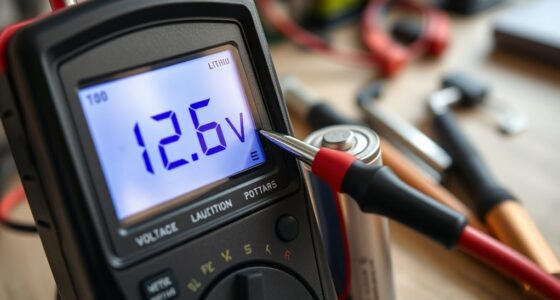Balancing cells is key to making your battery pack last longer and stay safer. When individual cells aren’t balanced, some can become overcharged while others are underused, which speeds up aging and reduces capacity. Proper cell balancing keeps each cell’s voltage and energy aligned, preventing damage and extending your battery’s lifespan. By ensuring peak performance and safety, you get more value from your investment. Keep exploring to discover how balancing techniques can protect your battery over time.
Key Takeaways
- Proper cell balancing prevents voltage imbalance, ensuring all cells operate within safe, optimal ranges.
- Balancing extends battery lifespan by reducing stress and aging on individual cells.
- Maintaining charge equality improves overall pack efficiency and performance.
- Active and passive balancing methods continuously correct cell voltage differences for reliability.
- Regular balancing minimizes capacity loss, enhances safety, and maximizes the longevity of the battery pack.

Balancing cells is an essential process in maintaining the health and efficiency of batteries, especially in devices like electric vehicles and renewable energy systems. When you understand how to keep each cell in the pack working together, you can substantially extend its lifespan and performance. The key lies in managing cell voltage and ensuring charge equality across all cells. Each cell in a battery pack has a voltage level that indicates how much energy it holds. If some cells have a higher voltage than others, it suggests they’re more charged, while lower-voltage cells are less charged. This imbalance can cause problems, like reduced capacity or even damage to the battery over time.
When cells are out of sync, the overall pack can’t deliver its maximum potential. You might notice decreased runtime or efficiency, and in worst cases, some cells could become overcharged or deeply discharged, which accelerates aging. That’s where balancing comes into play. By actively monitoring and adjusting cell voltage, you help maintain charge equality—making sure every cell holds a similar amount of energy. This process prevents individual cells from becoming overburdened or underutilized, which is vital for longevity.
There are different methods to balance cells, but the goal remains the same: equalize the charge across all cells. Passive balancing involves diverting excess energy from the higher-voltage cells to the lower-voltage ones, often through resistors and circuitry. Active balancing, on the other hand, moves energy directly between cells, making the process more efficient, especially in large battery packs like those in electric vehicles. By continuously balancing, you prevent the cells from drifting apart in voltage, which maintains the overall health of the pack. Additionally, integrating data analytics into the monitoring process can help detect early signs of imbalance and optimize balancing strategies.
If you neglect balancing, you risk creating a cycle where some cells become overcharged while others are undercharged, leading to capacity loss and shorter lifespan. Proper balancing guarantees that each cell reaches its full capacity without pushing beyond safe limits. It also stabilizes the pack’s voltage, making it more reliable and safer to use. Regular maintenance and monitoring are essential; with the right balancing system, you can keep the cells synchronized, optimize energy use, and extend the life of your battery pack.
In essence, balancing cells isn’t just about maintaining current performance — it’s about safeguarding your investment and ensuring long-term reliability. By keeping cell voltage within safe, balanced levels, you’re giving each cell an equal chance to perform at its best. This results in a longer-lasting, more efficient battery pack that delivers the power you need when you need it.
Frequently Asked Questions
How Often Should Cell Balancing Be Performed?
You should balance your battery cells regularly to guarantee ideal performance and longevity. How often depends on your charging frequency and overall usage, but a good rule of thumb is to check and balance cells every few months or whenever you notice uneven charging or voltage differences. Incorporate cell balancing into your maintenance schedule to keep your pack healthy and prevent premature failure, especially during high or frequent charge cycles.
Can Improper Balancing Damage Battery Cells?
Think of your battery like a orchestra; improper balancing is like musicians playing out of tune. When you neglect to balance cells, differences in cell voltage and internal resistance can cause uneven wear, leading to damage. Over time, this imbalance stresses individual cells, possibly causing overheating or capacity loss. So, yes, improper balancing can harm your battery, reducing its lifespan and efficiency. Regular balancing keeps your pack harmonious and healthy.
What Are Signs of Unbalanced Cells?
You might notice signs of unbalanced cells when cell voltage varies markedly across your battery pack, causing inconsistent performance. A capacity mismatch can lead to uneven discharge, reducing overall efficiency. If some cells drain faster or show different charge levels during charging or discharging, it indicates imbalance. Monitoring cell voltage regularly helps you spot these issues early, ensuring your pack stays healthy and lasts longer.
Is Balancing Necessary for All Types of Batteries?
You might wonder if balancing is necessary for all batteries. It depends on the battery chemistry and the quality of the cells. For lithium-ion batteries, balancing technology helps prevent capacity loss and extends lifespan by ensuring all cells charge evenly. However, some older or simpler battery types may not need balancing. Always check your battery’s specifications to determine if balancing is recommended for peak performance and longevity.
How Does Temperature Affect Cell Balancing?
You might think temperature doesn’t influence cell balancing, but thermal effects actually play a vital role. When temperatures fluctuate, they impact the efficiency impact of balancing circuits, causing cells to charge or discharge unevenly. Hotter cells tend to balance faster due to increased chemical activity, while colder cells slow down, risking imbalance. Maintaining batteries within a suitable temperature range guarantees better balancing, prolonging pack life and preserving overall efficiency.
Conclusion
Balancing your cells isn’t just a fancy trick—it can extend your battery’s lifespan considerably. Did you know that poorly balanced cells can reduce a battery’s capacity by up to 20% over time? By regularly balancing, you ensure each cell shares the load equally, helping your pack last longer and perform better. So, take a few minutes to balance those cells; it’s a simple step that pays off with a more reliable, longer-lasting battery.










